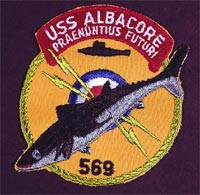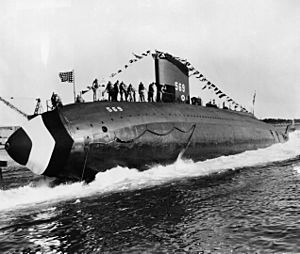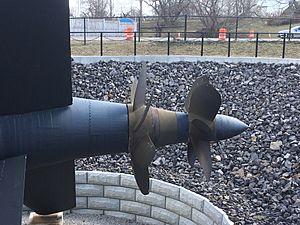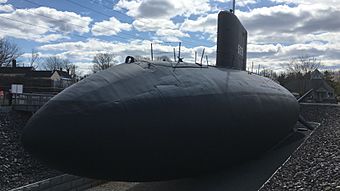USS Albacore (AGSS-569) facts for kids

USS Albacore off the coast of Rhode Island
|
|
Quick facts for kids History |
|
|---|---|
| Name | Albacore |
| Namesake | Albacore |
| Ordered | 24 November 1950 |
| Builder | Portsmouth Naval Shipyard of Kittery, Maine |
| Laid down | 15 March 1952 |
| Launched | 1 August 1953 |
| Sponsored by | Mrs. J. E. Jowers, the widow of Chief Motor Machinist's Mate Arthur L. Stanton, lost with the second Albacore (SS-218) |
| Commissioned | 6 December 1953 |
| Decommissioned | 9 December 1972 |
| Stricken | 1 May 1980 |
| Motto |
|
| Status | Donated as a museum and memorial in Portsmouth, New Hampshire |
| Badge |  |
| General characteristics - Final Phase 4 Configuration | |
| Displacement | 1606.62 tons surface 1823.51 tons submerged |
| Length | 205 ft 4.75 in (62.6047 m) Length between perpendiculars 200 ft 0 in (60.96 m) |
| Beam | 27 ft 3.75 in (8.3249 m) |
| Draft | Forward 19 ft 1 in (5.82 m) Aft 22 ft 3 in (6.78 m) |
| Propulsion | Two 7,500 shp, counter-rotating electric motors, Two 1,000 bhp/817 kW diesel/electric generators |
| Speed |
|
| Range | Varied with configuration |
| Complement | 5 officers, 49 men |
| Armament | None |
The USS Albacore (AGSS-569) was a special research submarine for the United States Navy. It was built to test new ideas for how submarines should be shaped. Its unique "teardrop hull" design helped make modern submarines faster and easier to steer underwater.
This submarine was the third ship in the U.S. Navy to be named after the albacore, a type of tuna fish. Its construction began on March 15, 1952, at the Portsmouth Naval Shipyard in Kittery, Maine. The Albacore was launched on August 1, 1953, and officially joined the Navy on December 6, 1953.
After World War II, countries like the United States and the Soviet Union realized how important submarines were. They wanted to build even better ones. The idea of nuclear power for ships made people think about submarines that could stay underwater for a very long time. This led to the need for new designs, like the Albacore, to make submarines super fast and agile underwater.
Contents
Designing a Faster Submarine
After World War II, experts started thinking about how to use atomic energy for ships. They realized that nuclear power plants wouldn't need oxygen, which meant submarines could stay underwater much longer. This sparked the idea for a new kind of submarine that was built for speed and agility underwater, not just on the surface.
In 1949, a special team began studying different shapes for submarine hulls. They wanted to find the best design for moving through water. Many designs were tested at the David Taylor Model Basin in Maryland and in a wind tunnel in Virginia.
To avoid too much interference, Admiral Momsen suggested building a submarine just for testing. It would be unarmed and designed purely for speed. This led to the approval of the Albacore's construction on November 25, 1950. The Albacore was classified as an auxiliary submarine, meaning it was a special kind of support vessel.
Testing the New Design

After it was built, the Albacore left Portsmouth on April 8, 1954, for its first training trips. Its job was to try out new designs and then return to the shipyard for changes. This helped the Navy learn how to build better submarines in the future.
During its early tests, the Albacore showed it could go as fast as older submarines, but with half the engine power! This was a huge success. It traveled to places like New London, Connecticut, and Key West, Florida, for different operations.
In October 1955, Arleigh Burke, a top Navy officer, took a short trip on the Albacore. Even Lord Mountbatten from the United Kingdom joined him. This showed how important the submarine was for testing new ideas.
From December 1955 to March 1956, the Albacore got a new stern (the back part). Its propeller, which used to be surrounded by steering parts, was now behind them. This made the submarine look more like a blimp and helped with its speed.
In May 1956, the Albacore made history in New York City. It was part of a TV show called Wide, Wide World. Cameras were attached to its front, and people watched live as it dove underwater. This was the first time a submarine dive was shown live on television!
More Experiments and Changes
The Albacore kept getting new parts and being tested. In November 1956, its engines were changed. Then, in 1958, it had a big check-up. During this time, special sound-damping material was added to make it quieter. Its bow planes (small wings at the front) were even removed to reduce noise further.
Later in 1958, the Albacore helped the Canadian Armed Forces practice finding submarines. In 1959, a new, larger propeller was installed and tested. It also tried out a special curved sonar dome at the front.
The lessons learned from the Albacore helped design the Barbel-class submarine. These submarines looked similar to the Albacore but were longer. Only one of these, the USS Blueback (SS-581), is still around today as a museum ship.
Big Upgrades and New Features
On November 21, 1960, the Albacore went into the shipyard for a huge makeover. It received a new, experimental X-shaped tail, which helped it steer better. It also got 10 dive brakes around its body, a new bow, and new sonar systems.
In 1962, it got an advanced sonar system called DIMUS. Then, in December 1962, it began its fourth major upgrade. This included special contra-rotating propellers (two propellers spinning in opposite directions) and a powerful new battery. It also received new radio and sonar equipment.
After these changes were finished in March 1965, the Albacore went to Florida to test everything out. This was the second time it set a world record for submarine speed underwater! It continued to test its new features until August 1966, when it went back to the shipyard for more adjustments to its propellers and battery.
In 1968, the submarine had more changes to its propulsion system. It then tested new systems in the Tongue of the Ocean, a deep channel in the Bahamas. The Albacore was always busy trying out the latest technology.
From 1970 to 1971, the Albacore underwent another overhaul for "Project SURPASS." This project researched using a special liquid (polymer mixed with fresh water) to reduce drag and make the submarine move even faster through the water.
Retirement of a Pioneer
The Albacore started having frequent engine problems, which caused many delays. Because of these issues and a lack of spare parts for its unique engines, the Project SURPASS tests were canceled.
A ceremony was held on September 1, 1972, to mark its retirement. Navy officials praised the Albacore for its contributions to science. The submarine was officially taken out of service on December 9, 1972. It was then stored at a facility in the Philadelphia Naval Shipyard. Its name was removed from the Navy's list of active ships on May 1, 1980.
How the Albacore Changed Over Time
The Albacore's life was full of changes, like a science experiment that kept evolving. Here are the main phases of its design:
- Phase I (1953-1955): It started with bow planes and control surfaces behind the propeller.
- Phase II (1956-1960): The control surfaces moved to the front of the propeller, and a larger propeller was installed.
- Phase III (1961-1962): It got an X-shaped tail, dive brakes, and a bigger rudder.
- Phase IV (1965-1970): The back part of the hull was made larger for two main motors, contra-rotating propellers, and a powerful new battery.
- Phase V (1971-1972): It was modified to test polymer injection to reduce drag.
A Lasting Legacy
A group called the Portsmouth Submarine Memorial Association worked hard to bring the Albacore back to Portsmouth. They wanted to put it on permanent display for everyone to see. In April 1984, the Albacore was towed 575 miles back to Portsmouth Naval Shipyard.
Moving the submarine to its final display spot in May 1985 was a big challenge. It involved removing a railway bridge and digging a temporary channel across a road. The Albacore even got stuck in the mud for a while! But finally, on October 3, 1985, it was successfully placed in its special cradle.
After a lot of volunteer work, the Albacore opened to the public on August 30, 1986. For over two decades, the Albacore helped the Navy learn a lot about how submarines move through water. This knowledge was used to design all future Navy submarines, making them faster, quieter, and safer.
Today, the Albacore is located at Albacore Park in Portsmouth, New Hampshire, and is open for visitors. The Visitors Center is expanding to show more about the Albacore's history and other maritime stories. The Albacore is recognized as a National Historic Landmark and was added to the Submarine Hall of Fame in 2005.
Image gallery
Exterior views
Interior views
See also
 In Spanish: USS Albacore (AGSS-569) para niños
In Spanish: USS Albacore (AGSS-569) para niños
- List of National Historic Landmarks in New Hampshire
- National Register of Historic Places listings in Rockingham County, New Hampshire
- USS Barbel (SS-580) - The first diesel submarine with a teardrop hull, inspired by Albacore.
- USS Blueback (SS-581) - The last conventionally-powered attack submarine in the U.S. Navy, now a museum ship.
- USS Bonefish (SS-582) - The last conventionally powered submarine built for the US Navy.
Other U.S. Navy research submarines:
- Midget submarine X-1
- USS Dolphin
- Nuclear research submarine NR-1






















